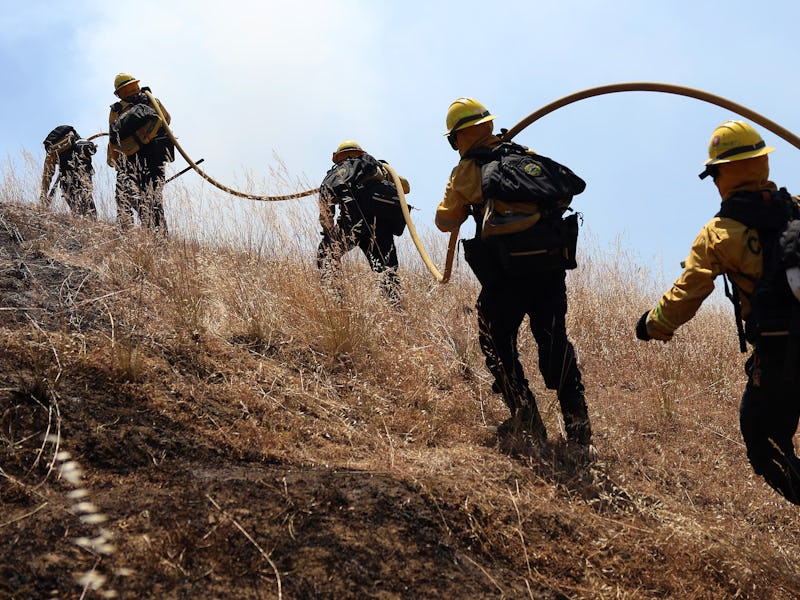Exposure to Wildfire Smoke Is Accelerating — Here’s Where the Current Risk Is Highest
New research reveals where people were exposed to wildfires and why.

Over the past two decades, a staggering 21.8 million Americans found themselves living within 3 miles of a large wildfire. Most of those residents would have had to evacuate, and many would have been exposed to smoke and emotional trauma from the fire.
Nearly 600,000 of them were directly exposed to the fire, with their homes inside the wildfire perimeter.
Those statistics reflect how the number of people directly exposed to wildfires more than doubled from 2000 to 2019, my team’s new research shows.
But while commentators often blame the rising risk on homebuilders pushing deeper into the wildland areas, we found that the population growth in these high-risk areas explained only a small part of the increase in the number of people who were exposed to wildfires.
Instead, three-quarters of this trend was driven by intense fires growing out of control and encroaching on existing communities.
That knowledge has implications for how communities prepare to fight wildfires in the future, how they respond to population growth, and whether policy changes such as increasing insurance premiums to reduce losses will be effective. It’s also a reminder of what’s at risk from human activities, such as fireworks on July 4, a day when wildfire ignitions spike.
Where wildfire exposure was highest
I am a climate scientist who studies the wildfire-climate relationship and its socioenvironmental impacts. For the new study, colleagues and I analyzed the annual boundaries of more than 15,000 large wildfires across the Lower 48 states and annual population distribution data to estimate the number of people exposed to those fires.
Not every home within a wildfire boundary burns. If you picture wildfire photos taken from a plane, fires generally burn in patches rather than as a wall of flame, and pockets of homes survive.
We found that 80 percent of the human exposure to wildfires — involving people living within a wildfire boundary from 2000 to 2019 — was in Western states.
California stood out in our analysis. More than 70 percent of Americans directly exposed to wildfires were in California, but only 15 percent of the area burned was there.
What climate change has to do with wildfires
Hot, dry weather pulls moisture from plants and soil, leaving dry fuel that can easily burn. On a windy day — such as California often sees during its hottest, driest months — a spark, for example, from a power line, campfire, or lightning, can start a wildfire that quickly spreads.
Recent research published in June 2023 shows that almost all of the increase in California’s burned area in recent decades has been due to anthropogenic climate change — meaning climate change caused by humans.
Our new research looked beyond just the area burned and asked: Where were people exposed to wildfires, and why?
We found that while the population has grown in the wildland-urban interface, where houses intermingle with forests, shrublands, or grasslands, that accounted for only about one-quarter of the increase in the number of humans directly exposed to wildfires across the Lower 48 states from 2000 to 2019.
Three-quarters of that 125 percent increase in exposure was due to fires’ increasingly encroaching on existing communities. The total burned area increased by only 38 percent, but the locations of intense fires near towns and cities put lives at risk.
In California, which was in drought during much of that period, several wildfire catastrophes hit communities that had existed long before 2000. Almost all these catastrophes occurred during dry, hot, windy conditions that have become increasingly frequent because of climate change.
Wildfires in the high mountains in recent decades provide another way to look at the role that rising temperatures play in increasing fire activity.
High mountain forests have few cars, homes, and power lines that could spark fires, and humans have historically done little to clear brush there or fight fires that could interfere with natural fire regimes. These regions were long considered too wet and cool to burn regularly. Yet my team’s past research showed fires have been burning there at unprecedented rates in recent years, mainly because of warming and drying trends in the Western U.S.
What can communities do to lower the risk?
Wildfire risk isn’t slowing. Studies have shown that even in conservative scenarios, the amount of area that burns in Western wildfires is projected to grow in the next few decades.
How much these fires grow and how intense they become depends largely on warming trends. Reducing emissions will help slow warming, but the risk is already high. Communities will have to both adapt to more wildfires and take steps to mitigate their impacts.
Developing community-level wildfire response plans, reducing human ignitions of wildfires, and improving zoning and building codes can help prevent fires from becoming destructive. Building wildfire shelters in remote communities and ensuring resources are available to the most vulnerable people are also necessary to lessen the adverse societal impacts of wildfires.
This article was originally published on The Conversation by Mojtaba Sadegh at Boise State University. Read the original article here.